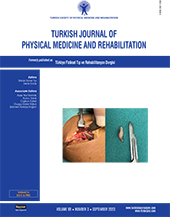The effects of transcutaneous auricular vagus nerve stimulation on visual memory performance and fatigue
2 Bahçeşehir University, Physiotherapy and Rehabilitation, Istanbul, Türkiye
3 Artvin Çoruh University, Vocational School of Health Services, Artvin, Türkiye DOI : 10.5606/tftrd.2023.11174 Objectives: This study aims to investigate the effects of transcutaneous auricular vagus nerve stimulation (taVNS) on visual memory performance and fatigue in healthy individuals.
Patients and methods: Between April 10, 2022 and May 25, 2022, a total of 60 physical therapy and rehabilitation students (27 males, 33 females; mean age: 20.6±1.6 years; range, 18 to 24 years) were included in the study. The individuals were divided into two groups as the experimental group (n=30) and the control group (n=30). The experimental group received taVNS, mobile device supported games, and low-medium intensity aerobic exercises, while the control group received mobile device supported games and aerobic exercises. The personal information form was applied to all participants. The level of fatigue was measured using a computer-based evaluation and Fatigue Severity Scale (FSS) to analyze the visual memory performance.
Results: All parameters used to evaluate visual memory performance showed a significant difference, while the FSS scores showed no significant difference (p>0.05). Only one sub-parameter in the control group was significantly different, while none of the other sub-parameters or FSS scores were significantly different (p>0.05). There was a significant difference between the two groups in terms of two of the visual memory sub-parameters, although no significant difference was found for the results of one parameter and the FSS (p>0.05).
Conclusion: Our study results show that taVNS can produce positive effects on visual memory performance, although it does not apparently affect fatigue.
Keywords : Fatigue, transcutaneous auricular vagus nerve stimulation, visual memory

















